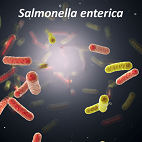16S rDNA PCR Detection of Salmonella enterica in Blood |
| 06 December 2018 |
|
So, there is an urgent need for a sensitive and specific assay for the identification of S. enterica strains. Rapid and accurate detection of serovars directly in samples would aid patient care, particularly in cases of bloodstream infections. Masek et al. [1] addressed this problem by following a molecular approach that may be regarded as a useful method supporting culture diagnosis. The method involves PCR amplification of a set of three hypervariable regions (V1, V3, V6) of the 16S rRNA gene combined with high resolution melt analysis. The procedure generates signatures that group S. enterica into the nine typhoidal and nontyphoidal serovars used in the study. Mock cultures diluted in EDTA blood were used to determine the limit of detection (LOD) of all strains. For this, a pre-treatment of the 5-ml blood samples with MolYsis™ Basic5 (Molzym, Germany) was performed that lyses human cells and degrades the released DNA quantitatively. Extracts from samples depleted of human DNA are known to increase the subsequent PCR analysis of bacterial gene targets compared to total DNA extracts [2]. As a result, Masek et al. determined the LODs of the nine serovars at <1 to 9 cfu/ml blood which are in the lower limits of concentrations of S. enterica infections. On the grounds of these results, the authors regarded the method as potentially useful for rapid direct diagnosis of S. enterica serovars in the clinical routine. However, this needs to be supported by clinical studies. |
| References |
| [1] Masek BJ, Hardick J, Won H, Yang S, Hsieh YH, Rothman RE, Gaydos CA (2014) Sensitive detection and serovar differentiation of typhoidal and nontyphoidal Salmonella enterica species using 16S rRNA Gene PCR coupled with high-resolution melt analysis. J Mol Diagn 16, 261–266. (link) |
| [2] Hansen WLJ, Bruggeman CA, Wolffs PFG (2009) Evaluation of new preanalysis sample treatment tools and DNA isolation protocols to improve bacterial pathogen detection in whole blood. J Clin Microbiol 47, 2629-2631. |
| Brochure Product Information |

 Worldwide, 22 million cases of typhoidal fever associated with more than 200,000 deaths are caused by typhoidal Salmonella enterica serovars annually. Despite this public health problem, the global burden is poorly understood due, in part, to a lack of suitable methods of diagnosis and surveillance.
Worldwide, 22 million cases of typhoidal fever associated with more than 200,000 deaths are caused by typhoidal Salmonella enterica serovars annually. Despite this public health problem, the global burden is poorly understood due, in part, to a lack of suitable methods of diagnosis and surveillance.